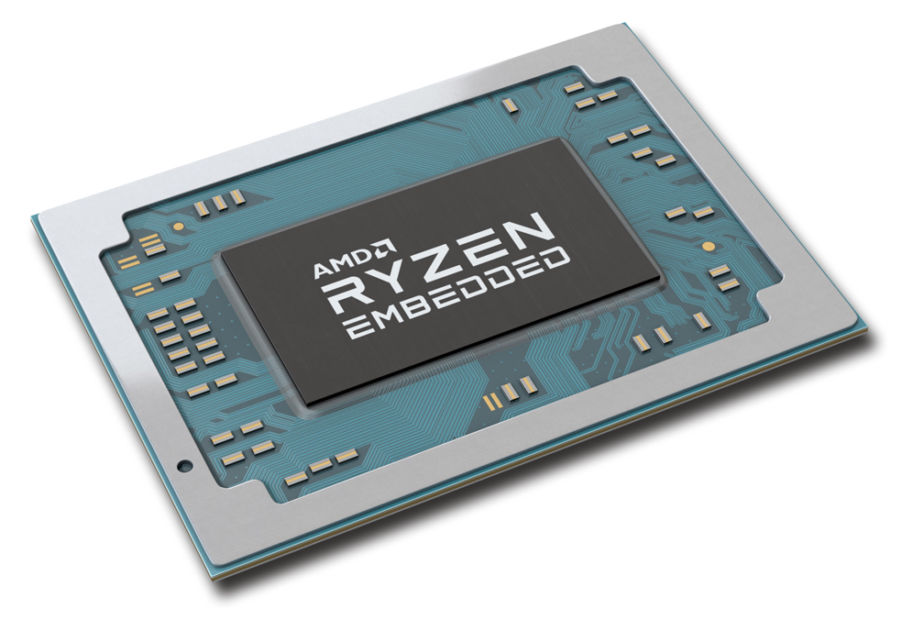AMD SoC targets machine vision and IoT
- July 7, 2022
- Steve Rogerson

At last month’s Embedded World in Nuremberg, AMD announced the Ryzen Embedded R2000 mid-range system-on-chip (SoC) processors for industrial and robotics systems, machine vision, IoT and thin-client equipment.
The series doubles the core count and delivers a performance uplift compared with the prior generation, with the R2514 model exhibiting up to 81 per cent higher CPU and graphics performance than the comparable R1000 series processor.
Performance-per-watt efficiency is also optimised using Zen+ core architecture with AMD Radeon graphics for multimedia capabilities. The processors can power up to four independent displays in 4K resolution.
The processors are scalable up to four Zen+ CPU cores with eight threads, 2Mbyte of L2 cache and 4Mbyte of shared L3 cache. This gives embedded designers flexibility to scale performance and power efficiencies with a single processing platform.
With support for up to 3200MT/s DDR4 dual-channel memory and expanded IO connectivity, the processors deliver 33 per cent higher memory bandwidth and up to double the IO connectivity compared with R1000 series processors.
“For industrial applications like robotics and machine vision as well as thin clients and mini-PCs, the Ryzen Embedded R2000 series raises the bar on performance and functionality,” said Rajneesh Gaur, corporate vice president at AMD. “The Embedded R2000 series provides system designers with more performance, optimised power and better graphics, all with a seamless upgrade path.”
They can power up to four independent displays in 4K resolution leveraging DisplayPort 1.4, HDMI 2.0b or eDP 1.3 interfaces. There can be up to 16 lanes of PCIe Gen3, two Sata 3.0 and six USB 3.2 Gen2 and 2.0 ports.
Operating system support includes Microsoft Windows 11/10 and Linux Ubuntu LTS.
Security features help protect sensitive data and validate code before it is executed and it uses the Californian firm’s Memory Guard for real-time DRAM encryption.
Planned product availability extends up to ten years, providing a long-lifecycle support roadmap.
One of the first products based on the processor is a gaming platform from Taiwanese firm Advantech. The DPX-S451 is for use in slot machines, casino games and betting terminals.
“It offers an unbeatable combination of computing power, graphics performance and security features ideal for regulated gaming,” said Dirk Finstel, associate vice president at Advantech. “The R2000 SoC enables the DPX-S451 to deliver superior performance when compared with previous generations, an over 33% increase, while maintaining a comparatively low-cost point.”
For applications with strict space constraints, DFI is developing a small form factor single board computer that combines its miniaturisation technology with the Ryzen processor for graphics-demanding edge applications. Expectations are to reduce current edge applications’ size with better overall imaging and machine-vision analysis.
“DFI is innovative in designing small-size computers with exceptional graphic performance for the industrial and embedded fields including casinos, gaming, automation, machine vision, healthcare and digital signage,” said Jarry Chang, senior director at DFI. “With the ground-breaking AMD Ryzen Embedded R2000 series, we expect to see many new opportunities for our products to take our customers’ applications to a brand-new level through the advanced graphic processing and computing capabilities.”
Albert Lee, executive vice president at IBase, said the processor was built on the Zen 2 x86 core architecture with improved 14nm process technology, Vega graphics and high-speed IOs.
“We are excited to be able to implement the hottest Ryzen Embedded R2000 processor to our robust embedded platforms including the MI993 Mini-ITX motherboard, SI-324-N2314 fanless digital signage player, and INA1600 desktop uCPE/SD-WAN appliance,” said Lee. “We look forward to providing the right solutions and time-to-market advantage to our customers’ projects in a wide range of market applications.”
Sapphire Technology is a longstanding AMD partner and supplier of components for a broad range of consumer and embedded products, with expertise in motherboards and graphics, mini-STX and play-centric applications.
“By leveraging the AMD Ryzen Embedded V1000 and R2000 SoCs in our latest Sapphire boards, we can increase CPU and GPU performance in our NUC, mini-STX and thin mini-ITX form factors, driving extraordinary graphics capabilities, supporting up to four simultaneous 4K resolution displays, and providing unprecedented performance-per-watt for our customers,” said Adrian Thompson, vice president of marketing at Sapphire Technology.





